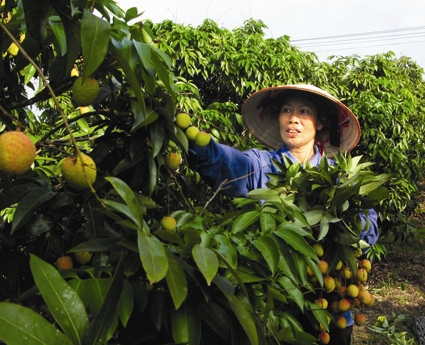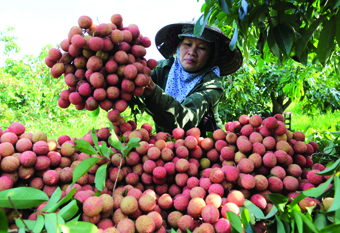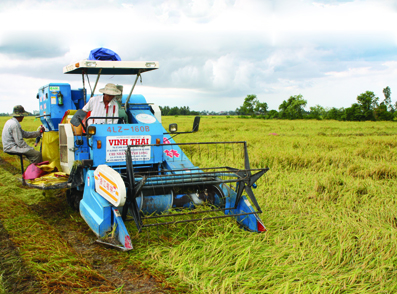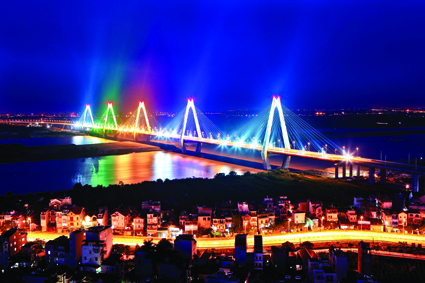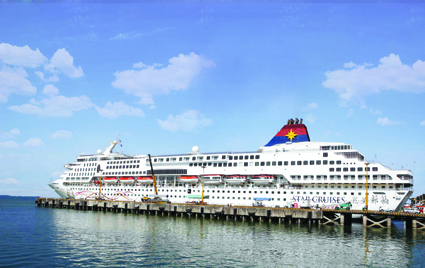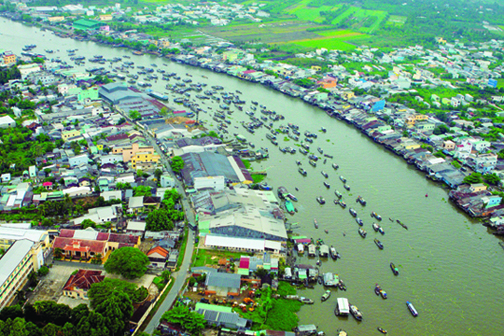Located in the central coast, Quang Ngai province borders Quang Nam province in the north, Binh Dinh province in the south, Kon Tum province and Truong Son mountain range in the west and the East Sea in the east. Covering some 5,152 square kilometers, the province has a population of more than 1.29 million people and is home to 29 ethnic groups with Kinh (Viet) being the most populous, followed by Hre, Co and Xo dang. It has a provincial city with the same name and 13 districts (including one island district). With a coastline of 130 kilometers, Quang Ngai boasts big potential for the development of sea economy and tourism.
Oil refining - hotspot in FDI attraction
Quang Ngai is one of the five provinces in the central key economic region (Thua Thien- Hue - Da Nang - Quang Nam - Quang Ngai - Binh Dinh). The province is connected with Quang Nam province by National Highway 1A and Kon Tum province by National Highway 24. The construction of the 140-kilometer Da Nang - Quang Ngai expressway is expected to be completed by mid-2017.
Quang Ngai province is to date home to the Dung Quat economic zone (EZ), four industrial parks and 15 industrial and traditional craft clusters.
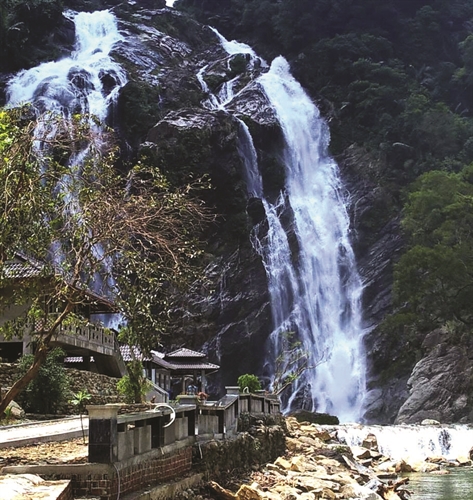 |
| Untouched beauty of Thac Trang (White Waterfall) in Minh Long district, Quang Ngai province __Photo: Vinh Trong/VNA |
Being one of the five coastal EZs in the country with investment from the state budget, the Dung Quat EZ will be expanded from current 10,300 hectares to more than 45,300 hectares (including 24,280 hectares of land and 10,752 hectares of sea surface). It is designed to become a multi-sectoral zone focusing on oil refining, petrochemical and heavy industries (steel-rolling and working, shipbuilding, mechanical engineering and cement production). The EZ is home to the country’s first heavy industry park, including oil refinery, heavy-equipment manufacture, plastic production, steel, and biofuel production. As the EZ is adjacent to Chu Lai airport (Quang Nam province) and has a deep-water seaport (Dung Quat seaport) and a complete infrastructure system, it has become an attractive investment destination for both domestic and foreign investors. In addition to the Government-provided investment incentives, investors in the EZ are entitled to corporate income tax exemption for four years since the generation of taxable income and 50-percent tax reduction in subsequent nine years and import duty exemption for five years since manufacture of raw materials, components and semi-finished products which are unavailable at home.
The Quang Ngai provincial Planning and Investment Department said that the province had granted investment licenses to eight foreign direct investment (FDI) projects with a combined registered capital of USD 89.23 million in the first nine months of this year. The newly-licensed projects from Singapore, Japan, Hong Kong, the Republic of Korea and Malaysia focus on real estate, afforestation, manufacture of electronic components and the provision of technical oil and gas services.
The province currently has 38 valid FDI projects totally capitalized at USD 4.1 billion. Specifically, Dung Quat EZ attracts 26 projects worth more than USD 3.9 billion while four IPs accommodate seven other projects with USD 66 million. The remaining five projects capitalized at USD 84.7 million are located outside the province’s EZ and IPs.
Pham Nhu So, Vice Chairman of the provincial People’s Committee and head of the Dung Quat EZ Management Board, said his province has constantly improved investment environment with priority given to the reform of administrative procedures, raising the provincial competitiveness index (PCI), and the introduction of mechanisms and policies to attract investors.
The provincial authorities have made public their telephone numbers and email addresses and formed an assistant group to help the provincial People’s Committee Chairperson in settling problems facing investors and enterprises in making investment or doing business in the locality. In addition, an inter-sectoral working group has been formed in the Dung Quat EZ and other IPs to assist investors and settle issues arising from their projects.
Until 2020, the province will continue attracting investment, focusing on sectors with comparative advantages to create high added value and maintain the province’s efficient and sustainable economic development and economic restructuring toward raising the industrial and service proportion, laying a firm foundation for building it into a modern industrialized province by 2020.
To reach the goals, Quang Ngai authorities are encouraging investment in seven fields, including oil refining and petrochemicals, large-scale heavy industries and supporting industries, seaports, logistics services, tourism services, building accommodations for workers and experts, and IP and urban infrastructure. Other industries that will be courted for investment are food processing, consumer goods, textile, light industries serving oil and gas and chemical industries, and mining.
To facilitate investment, the province has set out four solutions: creating a favorable and transparent environment, especially in land and planning policies, and attracting FDI to sectors with advantages, especially those using Dung Quat deep seaport, oil refining and petrochemical and heavy industries; prioritizing hi-tech agriculture, oil and gas projects, forming inter-disciplinary working groups to conduct investment promotion in the country and abroad; constantly updating investment promotion documents, incentive mechanisms and policies and list of projects calling for investment; and developing a database with information on specialized sectors and fields in English, Korean and Japanese.
Tourist potential
With a coastline of more than 130 kilometers, Quang Ngai province boasts numerous beautiful beaches, including Dung Quat and Khe Hai in Binh Son district, My Khe in Son Tinh district, Minh Tan, Duc Minh and Tan Dinh in Mo Duc district and Sa Huynh in Duc Pho district. Tourists can explore the beauty of Ly Son island, which is referred to as the kingdom of garlic with vast garlic fields all around. With an area of ten square kilometers, Ly Son, or Cu Lao Re, is 15 nautical miles northeast offshore Quang Ngai, and divided into An Vinh, An Binh and An Hai communes.
The province is also home to many ancient works such as Son My relic site, Thien An pagoda, Chau Sa ancient citadel, archaeological relics of Sa Huynh culture, one of the three cradles of civilization in Vietnam, alongside Dong Son and Oc Eo cultures.
Under the province’s tourism development master plan through 2020 with orientations toward 2025, Quang Ngai’s tourism sector is expected to become a key economic sector with a well-built infrastructure system and diverse high-quality and environment-friendly tourism products imbued with cultural identity.
Quang Ngai province is expected to receive 600,000 tourists, including 50,000 foreigners, this year and 950,000 tourists, including 70,000 foreigners, by 2020. Under the tourism master plan, the province plans to attract tourists from other ASEAN member countries and from Northeast Asian countries. It will also promote traditional markets like the US, Canada, Germany and the UK, and expand to new markets of the Middle East, Northern Europe, New Zealand and India.
To achieve the targets, the province will combine tourism and investment promotion activities. It will coordinate with tourism promotion agencies of the Vietnam National Administration of Tourism and Vietnam’s overseas representative agencies to promote tourism abroad.
Apart from tours to cultural and historical relics and traditional craft villages, the province will develop ecological tours to Ca Dam mountain in Tra Bong district and the white waterfall in Minh Long district, MICE (meetings, incentives, conferences, exhibitions) tours and tours to the Ly Son sea and island ecological tourist zone.
The province sets the target of raking in a tourism turnover of VND 500 billion (USD 26.1 million) this year and VND 880 billion (USD 40 million) by 2020.
The provincial People’s Committee said the province would need VND 2.6 trillion (USD 118.5 million) for 18 prioritized tourism investment projects in the 2014-2020 period.- (VLLF)

